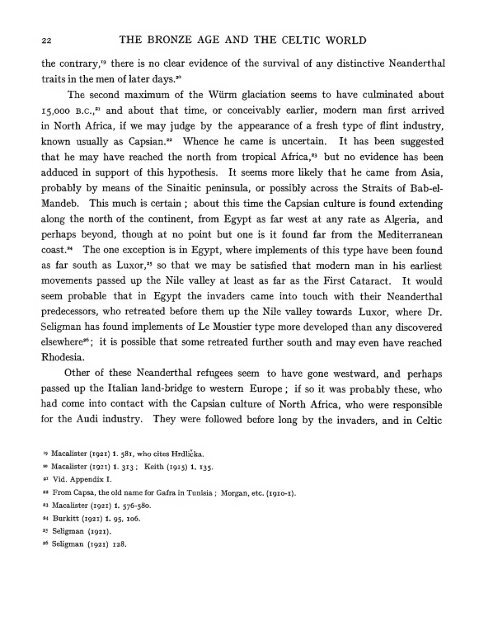The bronze age and the Celtic world - Universal History Library
The bronze age and the Celtic world - Universal History Library
The bronze age and the Celtic world - Universal History Library
Create successful ePaper yourself
Turn your PDF publications into a flip-book with our unique Google optimized e-Paper software.
22 THE BRONZE AGE AND THE CELTIC WORLD<br />
<strong>the</strong> contrary/' <strong>the</strong>re is no clear evidence of <strong>the</strong> survival of any distinctive Ne<strong>and</strong>erthal<br />
traits in <strong>the</strong> men of later days.'"<br />
<strong>The</strong> second maximum of <strong>the</strong> Wiirm glaciation seems to have culminated about<br />
15,000 B.C.," <strong>and</strong> about that time, or conceivably earlier, modem man first arrived<br />
in North Africa, if we may judge by <strong>the</strong> appearance of a fresh type of flint industry,<br />
known usually as Capsian." Whence he came is uncertain. It has been suggested<br />
that he may have reached <strong>the</strong> north from tropical Africa,*^ but no evidence has been<br />
adduced in support of this hypo<strong>the</strong>sis. It seems more likely that he came from Asia,<br />
probably by means of <strong>the</strong> Sinaitic peninsula, or possibly across <strong>the</strong> Straits of Bab-el-<br />
M<strong>and</strong>eb. This much is certain ; about this time <strong>the</strong> Capsian culture is found extending<br />
along <strong>the</strong> north of <strong>the</strong> continent, from Egypt as far west at any rate as Algeria, <strong>and</strong><br />
perhaps beyond, though at no point but one is it found far from <strong>the</strong> Mediterranean<br />
coast.** <strong>The</strong> one exception is in Egypt, where implements of this type have been found<br />
as far south as Luxor,"' so that we may be satisfied that modern man in his earliest<br />
movements passed up <strong>the</strong> Nile valley at least as far as <strong>the</strong> First Cataract. It would<br />
seem probable that in Egypt <strong>the</strong> invaders came into touch with <strong>the</strong>ir Ne<strong>and</strong>erthal<br />
predecessors, who retreated before <strong>the</strong>m up <strong>the</strong> Nile valley towards Luxor, where Dr.<br />
Seligman has found implements of Le Moustier type more developed than any discovered<br />
elsewhere** ;<br />
Rhodesia.<br />
it is possible that some retreated fur<strong>the</strong>r south <strong>and</strong> may even have reached<br />
O<strong>the</strong>r of <strong>the</strong>se Ne<strong>and</strong>erthal refugees seem to have gone westward, <strong>and</strong> perhaps<br />
passed up <strong>the</strong> Italian l<strong>and</strong>-bridge to western Europe ; if so it was probably <strong>the</strong>se, who<br />
had come into contact with <strong>the</strong> Capsian culture of North Africa, who were responsible<br />
for <strong>the</strong> Audi industry. <strong>The</strong>y were followed before long by <strong>the</strong> invaders, <strong>and</strong> in <strong>Celtic</strong><br />
'9 Macalister (1921) 1. 581, who cites Hrdlicka.<br />
"> Macalister (1921) 1. 313 ; Keith (1915) 1. 135.<br />
«' Vid. Appendix I.<br />
22 From Capsa, <strong>the</strong> old name for Gafra in Tunisia ; Morgan, etc. (1910-1).<br />
23 Macalister (1921) 1. 576-580.<br />
s+ Burkitt (1921) 1. 95, 106.<br />
25 Seligman {1921).<br />
2^ Seligman (1921) 128.







